An early grave of a Scythian warrior buried with a golden sword has been unearthed in the Mount Mamai cemetery near the village Velyka Znamyanka in Zaporizhia Oblast, central Ukraine.
Archaeologists exploring a small tumulus found a trench with animal bones and fragments of clay amphorae. There are characteristic Scythian funerary offerings. They then unearthed two graves within the mound: a large 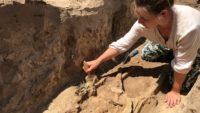 central one and a smaller one on the periphery. The central burial had been thoroughly looted in antiquity and archaeologists were only able to recover one arrowhead and some bone fragments. The remains suggest the occupant of this grave was an elderly male.
central one and a smaller one on the periphery. The central burial had been thoroughly looted in antiquity and archaeologists were only able to recover one arrowhead and some bone fragments. The remains suggest the occupant of this grave was an elderly male.
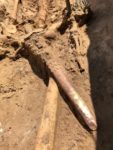 The accompanying grave had also been interfered with it, but it still contained the skeletal remains of a young man about 18-20 years old. He was interred with a rare large grey clay amphorae, fittings from a horse’s bridle, an iron battle axe, bronze and bone arrows and the star of the funerary show: an akinakes (a Scythian dagger or short sword) with a gold plated scabbard, a grip with a leaf motif and a cross-guard with granulation details.
The accompanying grave had also been interfered with it, but it still contained the skeletal remains of a young man about 18-20 years old. He was interred with a rare large grey clay amphorae, fittings from a horse’s bridle, an iron battle axe, bronze and bone arrows and the star of the funerary show: an akinakes (a Scythian dagger or short sword) with a gold plated scabbard, a grip with a leaf motif and a cross-guard with granulation details.
Not only had the young warrior been buried together with his weapons, but also with some ornaments; the archeological team found beads made of glass paste, a red deer tooth necklace, a gold earring and a gold pendant with chalk inlay.
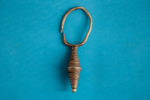 The Mount Mamai burial grounds, the largest barrow cemetery in the region and one of the largest in Europe, has been excavated for 32 years, a long-term salvage operation to recover as much archaeological material as possible before the site is destroyed by erosion from the construction of the Khakhovka Reservoir. Already a quarter mile of the shore has fallen into the lake in just three decades, so archaeologists are fighting a battle against time. Artifacts and remains dating as far back as the Neolithic era through the Middle Ages have been unearthed there. Of the 700 burials thus far excavated, around 400 are Scythian.
The Mount Mamai burial grounds, the largest barrow cemetery in the region and one of the largest in Europe, has been excavated for 32 years, a long-term salvage operation to recover as much archaeological material as possible before the site is destroyed by erosion from the construction of the Khakhovka Reservoir. Already a quarter mile of the shore has fallen into the lake in just three decades, so archaeologists are fighting a battle against time. Artifacts and remains dating as far back as the Neolithic era through the Middle Ages have been unearthed there. Of the 700 burials thus far excavated, around 400 are Scythian.
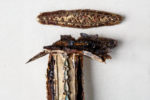 The discoveries made this season are so exceptional the 32nd dig has been dubbed the most successful yet. The very fine grave goods would be more than significant on their own, but the burial is even more notable because it dates to the 6th century B.C., making it the earliest Scythian burial found at Mount Mamai and extending the window of the cemetery’s usage during the Scythian period. The other Scythian tombs that have been excavated there are at least two centuries older.
The discoveries made this season are so exceptional the 32nd dig has been dubbed the most successful yet. The very fine grave goods would be more than significant on their own, but the burial is even more notable because it dates to the 6th century B.C., making it the earliest Scythian burial found at Mount Mamai and extending the window of the cemetery’s usage during the Scythian period. The other Scythian tombs that have been excavated there are at least two centuries older.
The objects have been cleaned and will be conserved at the Museum of Local History in Kamianets-Dniprovsky.

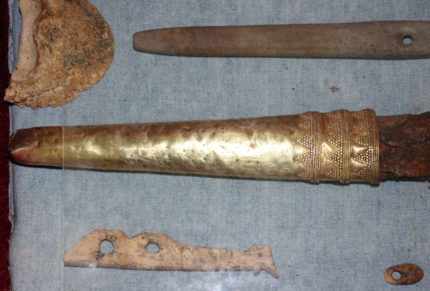
Akinakes?!? – To Arms!!! :skull: …τούτῳ δὲ τῷ ἀκινάκῃ θυσίας ἐπετείους προσάγουσι προβάτων καὶ ἵππων, καὶ δὴ καὶ τοῖσιδ᾽ ἔτι πλέω θύουσι ἢ τοῖσι ἄλλοισι θεοῖσι· ..
Herodotus Bk.4, 62. To the others of the gods they sacrifice this way and these kinds of beasts, but to Ares [Ἄρης the grk. god of war] as follows:–In each district of the several governments they have a temple of Ares set up in this way:– bundles of brushwood are heaped up for about three furlongs in length and in breadth, but less in height; and on the top of this there is a level square made, and three of the sides rise sheer but by the remaining one side the pile may be ascended. Every year they pile on a hundred and fifty waggon-loads of brushwood, for it is constantly settling down by reason of the weather. Upon this pile of which I speak each people has an ancient iron sword set up, and this is the sacred symbol of Ares. To this sword they bring yearly offerings of cattle and of horses; and they have the following sacrifice in addition, beyond what they make to the other gods, that is to say, of all the enemies whom they take captive in war they sacrifice one man in every hundred, not in the same manner as they sacrifice cattle, but in a different manner: for they first pour wine over their heads, and after that they cut the throats of the men, so that the blood runs into a bowl; and then they carry this up to the top of the pile of brushwood and pour the blood over the sword. This, I say, they carry up; and meanwhile below by the side of the temple they are doing thus:–they cut off all the right arms of the slaughtered men with the hands and throw them up into the air, and then when they have finished offering the other victims, they go away; and the arm lies wheresoever it has chanced to fall, and the corpse apart from it.
————-
“According to Herodotus’ Histories, the Scythians worshipped a god he equated with the Greek Ares; unlike most other Scythian gods, he does not offer the indigenous name for this deity. While ranking beneath Tabiti, Api and Papaios in the divine hierarchy, this god was apparently worshipped differently from other Scythian gods, with statues and complex altars devoted to him. This type of worship is noted to be present among the Alans. Noting how Greek mythological Amazons are devotees of Ares and most likely based on Scythian warriors, some researchers have considered the possibility that a Scythian warrior women cult of this deity existed. Others have also posited that the “Sword of Mars” alludes to the Huns having adopted this deity.”
“Keres (Κῆρες), singular Ker (Κήρ), were female death-spirits. They were the goddesses who personified violent death and who were drawn to bloody deaths on battle fields. The word valkyrie derives from Old Norse valkyrja (plural valkyrjur), which is composed of two words; the noun valr (referring to the slain on the battlefield) and the verb kjósa (meaning “to choose”). Together, they mean “chooser of the slain”. The Greek word “Ker” etymologically means destruction, death.”